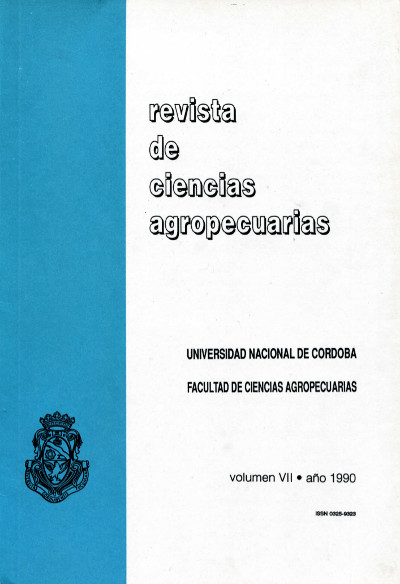Asociación simbiótica entre Atriplex aff. cordobensis Gand et Stukert (Cariofilales) y Frankia sp. (Actinomycetales)
Contenido principal del artículo
Resumen
Entre los microorganismos diazótrofos simbiontes en plantas no-leguminosas se cita el género Frankia (Actinomycetales). A. aff. cordobensis (Caryophyllales) es un arbusto forrajero que habita suelos de elevada alcalinidad (pH: 8,5-9). En el presente trabajo se propuso probar la asociación simbiótica Atriplex-Frankia, verificar la presencia de Actinomycetes en suelos áridos y lograr el aislamiento del endófito en medio artificial QMOD. La simbiosis Atriplex-Frankia fue demostrada, además las plantas que crecían en su suelo natural nodularon regularmente; esto demuestra que el género Frankia habita los suelos estudiados de regiones áridas. Las cepas aisladas crecieron en medio complejo QMOD y mostraron las características morfológicas típicas de Actinomycetes.
Detalles del artículo

Esta obra está bajo una licencia internacional Creative Commons Atribución-CompartirIgual 4.0.
Cómo citar
Referencias
Alexander, A. (1980). Introducción a la Microbiología del suelo. A.G.T. Editor.
Ambrogio, A. (1986). Manual de Técnicas de Histología Vegetal. Ed. Hemisferio Sur.
Baker, D. (1987). Opportunities for autoecological studies of Frankia, a symbiotic Actinomycete. Program for Forest Microbiology, School of Forestry and Environmental Studies, Connecticut.
Backing, J. (1970). Frankiaceae fam. nov. (Actinomycetales) with one new combination and six new species of genus Frankia Brunchorst 1866, 174. International Journal of Systematic Bacteriology, 20(2), 201-220.
Buchanan, R., & Gibbons, E. (1974). Bergey's manual of Determinative Bacteriology (8th ed.). The Williams & Wilkins Company.
Callaham, D., Del Tredici, P., & Torrey, G. (1978). Isolation and cultivation in vitro of the Actinomycete causing root nodulation in Comptonia. Science, 199(4327), 899-902.
Fontaine, M., Lancelle, S., & Torrey, G. (1984). Initiation and ontogeny of vesicles in cultured Frankia sp. strain HFP Ar 13. Journal of Bacteriology, 3(3), 921-927.
Gauthier, D., Frioni, L., Diem, G., & Dommergues, Y. (1984). La simbiosis Colletia spinosissima - Frankia. Acta Ecológica, 5(3), 231-239.
Lalonde, M., & Calvert, H. (1979). Production of Frankia hyphae and spores as an infective inoculant for Alnus species. In J. C. Gordon, C. T. Wheeler, & A. Perry (Eds.), Symbiotic Nitrogen Fixation in the Management of Temperate Forests (pp. 95-110). Forest Research Laboratory, Corvallis.
Lechevalier, M. (1986). Nitrogen fixing actinomycetes of the genus Frankia. Waksman Institute of Microbiology, Rutgers, The State University of New Jersey. Proceedings of the IV International Symposium on Microbial Ecology, 253-256.
McKnight, T. (1949). Efficiency of isolates of Rhizobium in the cowpea group with proposed addition to this group. Journal of Agriculture, 6(2), 61-76.
Parsons, R., Silvester, B., Harris, S., Gruijters, W., & Bullivant, S. (1987). Frankia vesicles provide inducible and absolute oxygen protection for nitrogenase. Plant Physiology, 83(3), 728-731.
Pommer, E. (1959). Uber die isolierung des endophyten aus den wurzelknollchen Alnus glutinosa Gaertn, and uber erfolgreiche reinfektions-versuche. Berichte der Deutschen Botanischen Gesellschaft, 72(2), 138-150.
Pizarro, M., Ayerza, R., & Karlin, U. (1986). Management of arboreal Prosopis in agroforestry production systems in the Dry Chaco, Argentina. Proyecto de investigación, convenio NAS-FCA. BOSTID (Board of Science and Technology for International Development).
Quispel, A. (1974). The Biology of Nitrogen Fixation. North Holland Publishing Company.
Rodriguez-Barrueco, C., Subramanian, P., & Martins-Logao, M. (1982). La fijación biológica de nitrógeno atmosférico y la producción vegetal. Anuario del Centro de Edafología Aplicada, 221(1), 221-241.
Romero, M. (1981). Contribuciones al estudio del género Atriplex (Chenopodiaceae) en la Argentina, I. Darwiniana, 23(1), 119-150.
Ruschel, P. (1980). Curso rápido sobre tecnología de Rhizobium. MIRCEN/UNESCO.
Schlegel, G. (1979). Microbiología General. Ed. Omega.
Vanderbosh, A., & Torrey, G. (1984). Consequences of sporangial development for nodule function in root nodules of Comptonia peregrina and Myrica gale. Plant Physiology, 76(2), 556-560.
Vanderbosh, A., & Torrey, G. (1985). Development of endophytic Frankia sporangios in field and laboratory grown nodules of Comptonia peregrina and Myrica gale. American Journal of Botany, 72(1), 99-108.
Woronin, M. (1986). Uber die bei del Schwarzerle (Alnus glutinosa) and del gewohnlichen garten-lupine (Lupinus mutabilis) auftretenden Wurzelanschwellungen. Memoires de l'Académie des Sciences de St. Pétersbourg, 101(1), 101-110.
Zhongze, A., & Torrey, G. (1984). Initiation and ontogeny of vesicles in cultured Frankia sp. strain HFP arl3. Journal of Bacteriology, 3(3), 921-927.
Zhongze, A., & Torrey, G. (1985). Studies of an effective strain of Frankia from Allocasuarina lehmaniana of Casuarinaceae. Plant and Soil, 87(1), 61-78.





